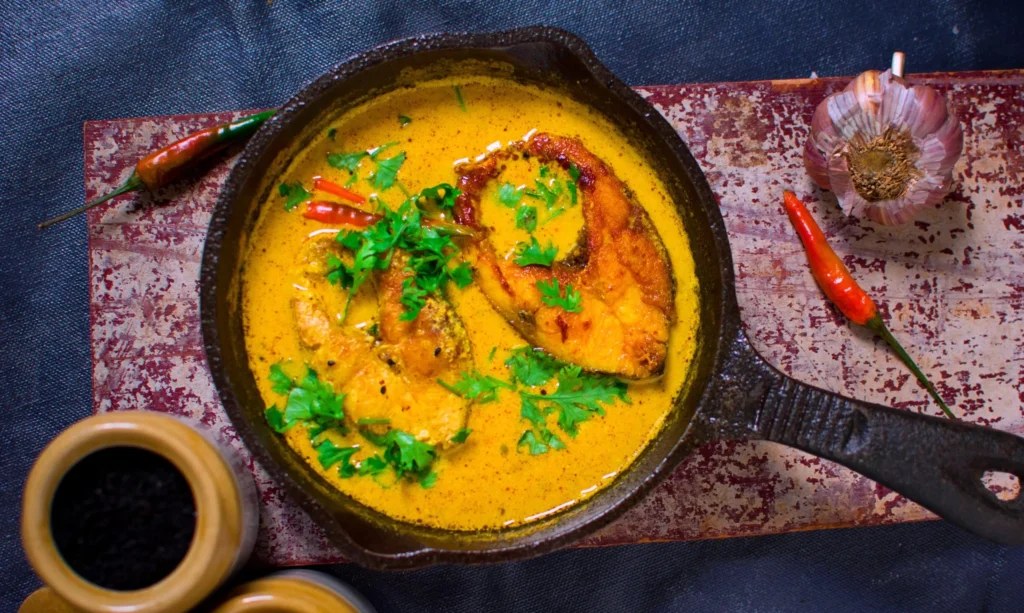Odia cuisine has many original dishes that are not found elsewhere. Besara is one of them. Not to say that it is completely unique as Bengali cuisine also has some dishes which are quite similar to besara.
What separates besara from regular ghanta curry is the use of mustard paste and mustard oil in the preparation. Sometimes, only mustard oil is enough to qualify a dish as besara. Here we are going to talk of vegetable besara. You an use any seasonal vegetable you have, in fact the ingredient list is almost the same as ghanta curry.

You can read our another post on Bali Yatra: The Celebration of Maritime Splendor
Ingredients
MUSTARD PASTE
- 2 Tbsp Indian mustard seeds
- 1/4 tsp cumin seeds
- 1 dried red chile
THE VEGETABLES
- Any seasonal vegetable you like, cut to small cubes
- 1 Indian bay leaf
- 1/2 cup grated coconut
- 2-3 Tbsp jaggery/sugar
- 1/2 tsp Panch phoron (Odis dry spice mix)
- 1 tsp mustard oil
- Ghee for frying
- salt to taste
Besara Recipe
- First let’s make the mustard paste. Soak the mustard seeds in water for 15 minutes. Then grind all the spices listed together with enough water to form a paste of pourable consistency. I find that mortar and pestle gives better texture to the paste compared to a spice grinder.
- Heat ghee in a deep pan on high flame and bloom the pancha phoron.
- Once the seeds start to sputter, add your vegetables to the pan and enough water to cover them. You do not want to sear the vegetables.
- Add the mustard paste, the gated coconut and the jaggery/sugar. You want a slightly sweet taste for the dish that is not overpowering. Season the vegetable with salt as needed.
- Reduce heat to medium and cook till the vegetables are almost done. Be sure to stir from time to time to prevent the vegetables from sticking to the bottom of the pan.
- Add the mustard oil slowly when the vegetables are almost done.
- Adjust for salt and serve hot with puris.
Besara is one of the Chappan Bhog of Lord Jagannath and can be found the year around in Puri. Its distinctive taste to mild heat always reminds me of temple food as it is served in many temple sponsored open kitchens.
www.snigdhamohanty.com
There is a non vegetarian version also available if you crave seafood. The fish is added separately after being cooked. However the distinctiveness of the dish is from the fact that the fish is actually ground to a paste before adding to the dish.
I hope you are well and safe during this quarantine and implore you to keep following social distancing procedures as COVID-19 is dangerous to us all. Just keep yourself busy and keep being the awesome people you are.
Get ready to immerse yourself in the aromatic world of Odia cuisine with the Odia book, “Besara: Traditional Odia Mustard Curry.” This captivating book showcases the rich flavors and cultural significance of Besara, a traditional mustard-based curry that tantalizes the taste buds and holds a special place in Odia culinary heritage.
“Besara: Traditional Odia Mustard Curry” unravels the story behind this delectable dish, diving deep into its origins and tracing its roots across generations. The book highlights the importance of Besara in Odia households, where it is often prepared to celebrate festivals, rituals, and family gatherings. It invites readers to explore the historical and cultural context that makes Besara an integral part of the Odia culinary legacy.
Through vivid descriptions and step-by-step instructions, the book unveils the secrets of preparing Besara. It delves into the art of selecting the right ingredients, grinding flavorful mustard seeds, and harmonizing the spices to achieve the perfect balance of flavors. With each turn of the page, readers are enticed to try their hand at recreating this traditional curry in their own kitchens, embracing the authentic taste of Odisha.
More: Wanted to download Odishashop.com visit here
“Besara: Traditional Odia Mustard Curry” goes beyond being just a recipe book; it is a celebration of the sensory experience and cultural significance associated with Besara. The book shares anecdotes, stories, and personal accounts from Odia families who have cherished Besara for generations. It provides insights into the diverse variations of Besara, highlighting regional nuances and the special touch that each family adds to their cherished recipe.
